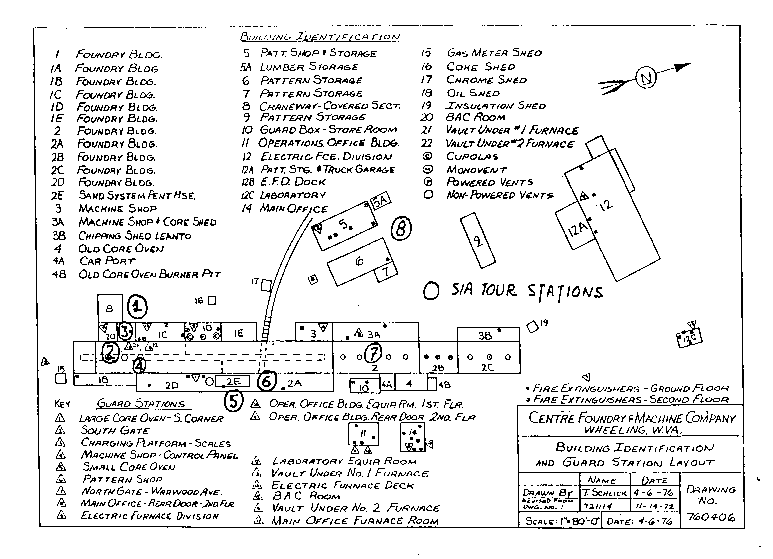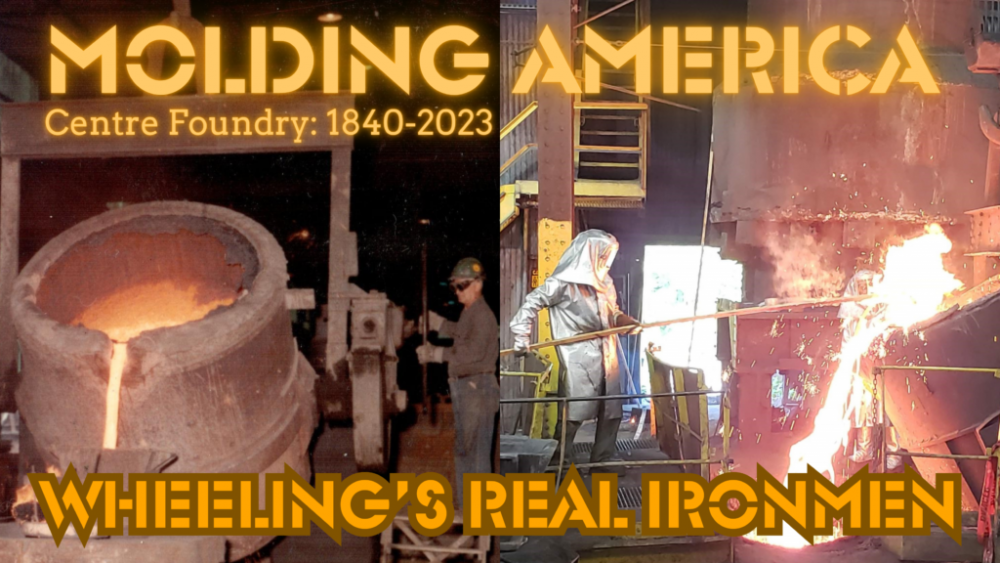
Centre Foundry Tour
Read "Molding America: A Brief History of Centre Foundry" by Sean Duffy at ArchivingWheeling.org.
Below-from a leaflet by Dr. Emory Kemp, 1990. Used with permission.
THE CENTRE FOUNDRY AND MACHINE COMPANY TOUR
INTRODUCTION
According to the Wheeling Intelligencer of 9 November 1867,
In the year 1846 Messrs. J. & A.J. Baggs erected a foundry on the corner of John and Fourth streets, near where the brick smoke house of Messrs. Pryor, Handlan & Co. now stands. [...] In 1850 they removed to the site occupied at present, and five years thereafter disposed of it to Messrs. Cecil & Bro. This firm continued to manufacture the same articles that their predecessors had done, up to the year 1865, when they sold out to Messrs. Cecil, Hobbs, & Co. From the date of the purchase by this last firm, they began to turn their attention to the production of machinery, principally the heavier class of work, suitable for the outfit of Rolling and Nail mills, for steamboat and other large engines.
They keep constantly employed in turning out this grade of machinery, between 35 and 40 men — the foundry department being under the personal supervision of Mr. David Greer, who has had 40 years experience in that branch of the business, and is regarded as a first class workman; and the pattern department, in which five men are employed, is in charge of Mr. Young, acknowledged to be one of the best mechanics in all this region. We visited both these departments, and were especially interested in the pattern rooms, in which we saw the curiously shaped and cunningly devised wooden forms of the principal casings molded during the last twenty years. What we saw in this room has cost thousands of dollars to make, and we felt and remarked that a fire in a few hours might totally obliterate the toil of years. Such costly treasures should be fully protected from a contingency involving so great a loss.
The melting facilities of this establishment consist of an old style cupola and one of McKenzie's patent blowers. Their capacity is 155 tons per day, but ordinarily about five tons per day are melted. Pittsburgh coke is used exclusively, being the best adapted to the purpose of any that can be procured in this region. [...]
The present proprietors of Centre Foundry are Messrs. A. J. Cecil, J. R. McCourtney, Edwin Hobbs and John Young. Wherever the machinery manufactured by them has been used, it has a splendid reputation for strength and solidity, for durability and thoroughness of construction. We are pleased to add that their business is rapidly extending, as is always the case when manufacturers are willing to use none but the best materials, employ the most skillful workmen, and turn out nothing but honestly made, first class work. To meet these requirements for success, Messrs. Cecil, Hobbs, & Co. have devoted themselves for years, and they are now receiving the rewards of their exertions.
Following the Civil War, heavy machinery was manufactured for rolling and nail mills and also engines for steamboats. Specialties in 1879 consisted of cast iron fronts, window sills, and fencing. John Young, a part-owner from ca. 1867, acquired control of the company in 1881. His family remained the owners until 1979, when it was sold to the current firm, Dyson-Kissner and Moran Corporation.
In 1923, the foundry moved to its present site in Warwood, where it produces molds and castings, primarily for the steel industry. They have also made castings for the suspension bridge and participated in the restoration of West Virginia Independence Hall, the Custom House. They cast and donated the front doors, decorative trim for the doors, interior shutters, and other architectural ironwork at their Warwood plant.

STATION 1. POWER PLANT
uring the nineteenth century, cast iron was produced using coke to melt iron in preparation for casting. The present plant has a simple material flow beginning at the south end of the plant and continuing to the north end, progressing through a variety of different steps and culminating in large castings, such as the molds for receiving twenty tons of molten steel. Instead of coke, the two furnaces of now supplied with electricity from power stations located both north and south of the plant. This electricity is received at 69,000 volts on Glenwood Heights; it is then brought to the plant and stepped down to a primary voltage of 4,160 and a secondary of 890 volts. The electrical system is designed so that, in the event of a power loss of the primary electrical source, electricity at 4,160 volts can be supplied from across the river at Martins Ferry. In addition, there is a diesel back-up system which would provide minimum service for lights, the overhead crane, and other necessary pieces of equipment, which would allow the molten content of the furnaces to be dumped rather than solidifying in either the furnace or ladles.
STATION 2. MATERIALS
At this station, we see scrap iron in the form of so-called "buttons" from blast furnace bottoms, ingotmolts, and other pieces scrap cast iron as well as occasional scrap steel. This scrap comes from a variety of sources, mostly from steel-producing factories in the Ohio Valley and Pittsburgh area. It is trucked to the Centre Foundry. Carbon, manganese, silicon, and other alloying materials are added to the molten metal to adjust the chemistry to meet specifications for cast iron. The carbon content varies from 3.9 to 4.3 percent.
STATION 3. RAIL LINE
Although the rail line may seem to start from nowhere and end nowhere, it serves an important role in the foundry process. It serves to move the raw material from outside the main building through a dryer, which heats the scrap to 650 degrees. It is then moved on to a pre-heating station, where the temperature is raised to 1,100 degrees Fahrenheit.
STATION 4. FURNACE
The scrap material, which has been preheated, is taken from the rail cars by large overhead cranes with attached electromagnets. The material is placed in the furnace and melted. The two furnaces are 55-40 ton vertical channel induction units and reach temperatures of approximately 2,700 degrees Fahrenheit. The material used to charge the furnace is carefully weighed so that the amount of metal to be melted is known and the chemistry can be adjusted to meet specifications.
STATION 5. HOPPERS
At this stationis located a series of hoppers containing sand material used in the molding process. The coarse molding sand is supplied from New Jersey. Two of the bins are used for recycled sand and one for new sand. In addition to the sand, clay in form of bentonite, sea coal, carbon, and organic materials are mixed in the proper percentages to provide an appropriate molding material. The material from the hoppers is placed in a muller and mixed with water so that is can be formed in a wooden mold.
STATION 6. POURING PITS
Located in front of you are the pouring pits. First, it is important to understand the mold-making process. Two types of sand casting materials are used. The green sand you see here is known as Dorchester gravel. It is material which, when mixed with a binder such as clay, can be compacted in a wooden mold. The compaction process is done with air-powered tools and results in a tightly packed material which will not crumble due to its density. Once this is done, the sand mold is baked in a oven and hardened. A second method is known as the no-bake method, using man-made materials and does not require any heating. At this time, the traditional green sand method is used far more often, due to its lower cost.
Once the sand mold has been hardened, it is ready to receive the molten cast iron. This is accomplished by pouring molten iron from the furnace into ladles which are transported to the molds by an overhead crane. The molds have flasks attached them, which receive the molten metal. There are also a system of "gates" that will allow the liquid metal to flow evenly into the mold. Vents allow gases to escape to prevent the formation of blow holes.
STATION 7. COOLING AREA
After the pour, the molds are allowed to cool in the pits and are covered with vermiculite, which acts as an insulation and allows the metal to cool slowly at the proper rate. The molds are left for several hours before being moved down the plant to cooling piles. Here, the sand molds are broken, revealing a casting which needs to be cleaned before final finishing. Using air-operated chippers (chisel-mounted jack hammers) and grinders, workmen remove any flashing or areas of coarseness from the surface of the metal. Once finished, the final casting is ready to be transported to the customer.
STATION 8. PATTERN SHOP
The pattern shop is located adjacent to the main plant building. It is here that wooden patterns were traditionally made for a wide variety of castings. Today, 85 to 90 percent of the patterns are supplied by subcontractors. Work in the pattern shop thus is largely one of service and maintenance to existing patterns. Patterns can be seen at station 7 and in a storage shed outside the main building.
See or print our brochure-length History of Centre Foundry
Video tour (2024) with Wheeling Heritage.
Iron & Steel Home | Wheeling Businesses | Places of Wheeling Home | Wheeling History Home | OCPL Home









